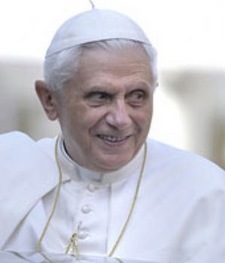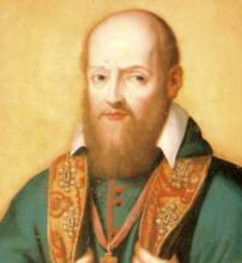Abide in My Love
 Deus Caritas Est and the Treatise on the Love of God
Deus Caritas Est and the Treatise on the Love of God
Nine years ago, on January 23, 2006, Pope Benedict XVI addressed the participants of a meeting of the Pontifical Council Cor Unum on the theme “But the Greatest of These is Love” (1 Cor 13:13). “Today,” he said, “the word love is so tarnished, so spoiled, and so abused, that one is almost afraid to pronounce it with one’s lips. And yet it is a primordial word, an expression of the primordial reality; we cannot simply abandon it, we must take it up again, purify it and give back to it its original splendor so that it might illuminate our life and lead it on the right path. This awareness led me to choose love as the theme of my first encyclical.” Pope Benedict XVI gave us Deus Caritas Est; Saint Francis de Sales gave us the Treatise on the Love of God.
 Attraction, Union, and Fruition
Attraction, Union, and Fruition
When I first studied Pope Benedict’s second encyclical, Spe Salvi, bits and pieces of Deus Caritas Est continued to echo in my heart. It occured to me that the proper Gospel (John 15:9-17) given in the reformed lectionary for the feast of Saint Francis de Sales engages us directly with the core message of Deus Caritas Est: a love that is at once desire (eros) and sacrificial self-gift (agápe), a love that is attraction, union, and fruition.
The Human Face and Heart of God
Pope Benedict XVI found some of his inspiration for Deus Caritas Est in Dante’s Divine Comedy. Poetry, and indeed all the arts, are rightly valued and used as the handmaids of theology. Such has always been the Catholic attitude toward the arts. Saint Francis de Sales knew well the distance separating the sensibility of Rome from that of Geneva. The Church of Dante, of Francis de Sales, and of Benedict XVI knows nothing of Calvinism’s cold disdain for the beauty that engages the senses. In the Catholic world-view, that which engages the senses with “the bands of love” (Hos 11:4) and draws the heart “with cords of compassion” (Hos 11:4) leads to the faith-vision of “the God who has assumed a human Face and a human Heart” (Benedict XVI, 23 January 2006).
Love Is Movement Toward the Good
In the Treatise on the Love of God Saint Francis de Sales speaks of the effect of what is loved on the one who loves. He calls it complaisance, meaning the pleasure or delight taken in something or someone. “Delight,” says the gentle bishop, “is the awakener of the heart, but love is its action; delight makes it get up, but love makes it walk. The heart spreads its wings by delight but love is its flight. Love then, to speak distinctly and precisely, is no other thing than the movement, effusion, and advancement of the heart towards good” (Treatise on the Love of God, Chapter XIV).
In Eternal Light’s Central Circle
Saint Francis de Sales compares the drawing power of love to a magnet attracting iron. Dante in Il Paradiso speaks of the love “which moves the sun and other stars.” Pope Benedict XVI, referring to Dante’s three circles of Eternal Light, says that one drawn into the Light by Love will discover in Eternal Light’s central circle a human face, the Face of Jesus Christ. “God,” says Pope Benedict XVI, “infinite Light, whose incommensurable mystery had been intuited by the Greek philosopher (Aristotle), this God has a human Face and — we can add — a Human heart” (Benedict XVI, 23 January 2006).
When Love Bends Low
The eros of God, that love by which God is drawn to us, and by which he attracts us to himself is also the love by which he bends low to us in mercy. Pope Benedict XVI teaches that “God’s eros is not only a primordial cosmic force, it is love that has created man and that bends before him, as the Good Samaritan bent before the wounded man, victim of thieves, who was lying on the side of the road that went from Jerusalem to Jericho” (Benedict XVI, 23 January 2006).
Faith in Love
The divine eros and the divine agápe converge in the Heart of Jesus; they are reflected and revealed on his Holy Face. Referring to Deus Caritas Est, Pope Benedict XVI said, “I wished to underline the centrality of faith in God, in that God who has assumed a human Face and a human Heart” (Benedict XVI, 23 January 2006).
The Food of Sacrificial Love
The Holy Sacrifice of the Mass is the divine eros and the divine agápe in motion. The Sacrifice offered from the Altar, being identical with the Sacrifice offered from the Cross, acts like a magnet on the believing soul. Holy Mass draws us into the circles of Eternal Light to discover in the Crucified the human face and the human Heart of God. It is the Eucharistic encounter with the Face and Heart of Crucified Love that changes us and fires us with a charity that goes beyond mere philanthropy. The Most Holy Eucharist is the food of those for whom doing good is not enough. It is the food of sacrificial love. Caritas Christi urget nos. “The charity of Christ,” a charity seen and tasted in the Eucharist, “impels us” (2 Cor 5:14).
